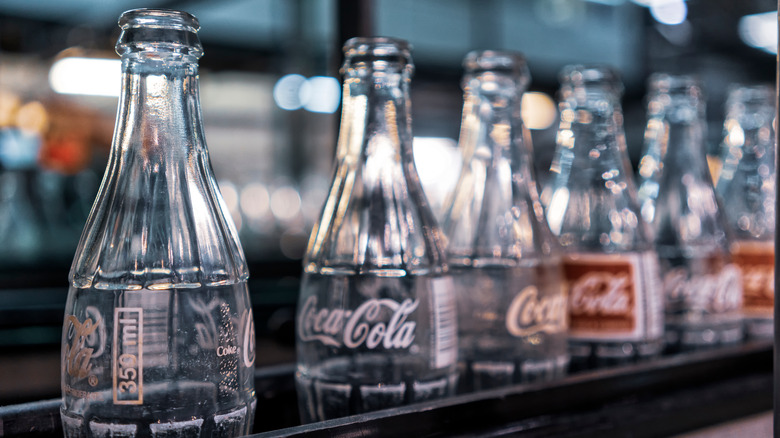The Little Known History Behind Coca-Cola Bottles
Coca-Cola is the most popular soft drink in the world, according to World Population Review, but you probably could have guessed that yourself, couldn't you? Few products in human history are more ubiquitous than Coke, which sells almost 2 billion servings per day in over 200 countries and territories. In fact, Coca-Cola is so far ahead of its competition in terms of name recognition that there are parts of the United States where they refer to every single type of soda, regardless of the brand or flavor, as Coke. It begs the question: How did this one brand manage to become literally synonymous with soda itself?
It can't be denied that Coca-Cola's unique taste — deriving from its famous yet closely guarded recipe — is a key part of its fandom, but clever marketing tactics have played an even bigger role in placing Coke atop the soft drink rankings. The brand is famous in the world of advertising, rolling out legendary slogans like "Drink Coca-Cola" and "The Official Soft Drink of Summer," alongside iconic images of Santa Claus and polar bears in its quest to dominate the beverage business.
But the secret weapon in all of Coke's advertising is something so subtle, that you've probably never realized how important it is. It's that famous glass bottle. Surely, you can picture it. No other drink comes in a bottle like that, and for good reason. The bottle was born from a vicious battle with Coke's competitors that dates back over 100 years.
Competitive origins
For the first decade of its life, Coca-Cola wasn't available in bottles at all. The drink was invented in 1886 by pharmacist John Pemberton of Atlanta, Georgia, and it was originally sold as a syrup for soda fountains. Pemberton died in 1888, never getting to see his invention flourish into a full-fledged global empire. But before his passing, he sold the business to Asa G. Candler, who oversaw a period of rapid growth that included —amongst other milestones — the first bottling of Coca-Cola.
In 1899, Tennessee lawyers Benjamin Thomas and Joseph Whitehead secured the rights to bottle Coca-Cola in a move that set the framework by which much of today's soft drink industry still operates. The original bottles looked nothing like the curvy Coke bottle we all know today; they were plain glass with straight sides, and this gave rise to a problem. The bottle was so generic that Coke's competitors were able to duplicate its branding almost to a tee.
The early 1900s gave rise to a slew of Coke competitors whose names made no attempt to hide their copycat nature. There was "Koca-Nola," "Toka-Cola," and the insultingly-on-the-nose "Koke." These companies used the same bottle as Coca-Cola and even copied their famous font. The Coca-Cola Company filed numerous lawsuits against these competitors, but it typically took years to resolve them. To protect themselves against copycats, Coke and its bottling associates decided to invest in brand-new packaging.
Coke's curves
In 1915, the board of the Coca-Cola Bottling Association issued a challenge to 10 American glass companies. Per the brief, they wanted a "bottle so distinct that you would recognize if by feel in the dark or lying broken on the ground," according to Coca-Cola United. The company with the winning design would receive $500 (equal to approximately $15,500 in 2023).
When the Root Glass Company of Terre Haute, Indiana received the challenge from Coke, they sent two employees — Earl Dean and Clyde Edwards — down to the local library to look for inspiration. The pair flipped through the dictionary and found the entry for cocoa beans, which reminded them of the name, Coca-Cola. Dean sketched out a bottle with a curvy shape akin to that of the bean. It was noticeably plumper than the bottle we know today, but the essence was the same. The Root Glass Company would go on to win Coke's competition and set the standard for its iconic curvy bottle.
There's a funny twist to this story; the iconic Coca-Cola bottle was invented due to a fundamental misunderstanding of the product. Earl Dean had looked up cocoa beans in the dictionary because he wanted to honor the Coca-Cola name. However, the "Coca" in Coca-Cola has nothing to do with cocoa beans. It actually refers to coca leaves, which are infamous as the source of cocaine, which was once part of Coke's formula.


